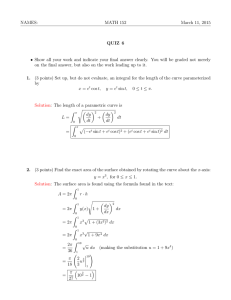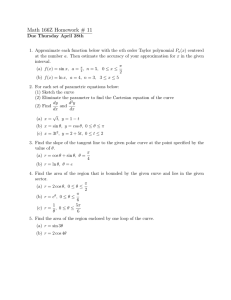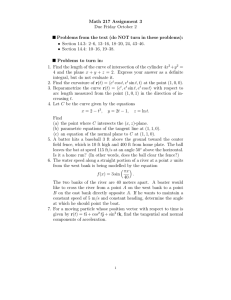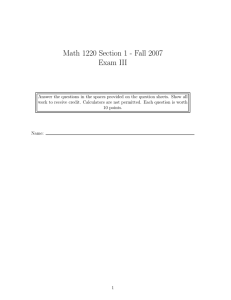18.01 Calculus Jason Starr Fall 2005
advertisement
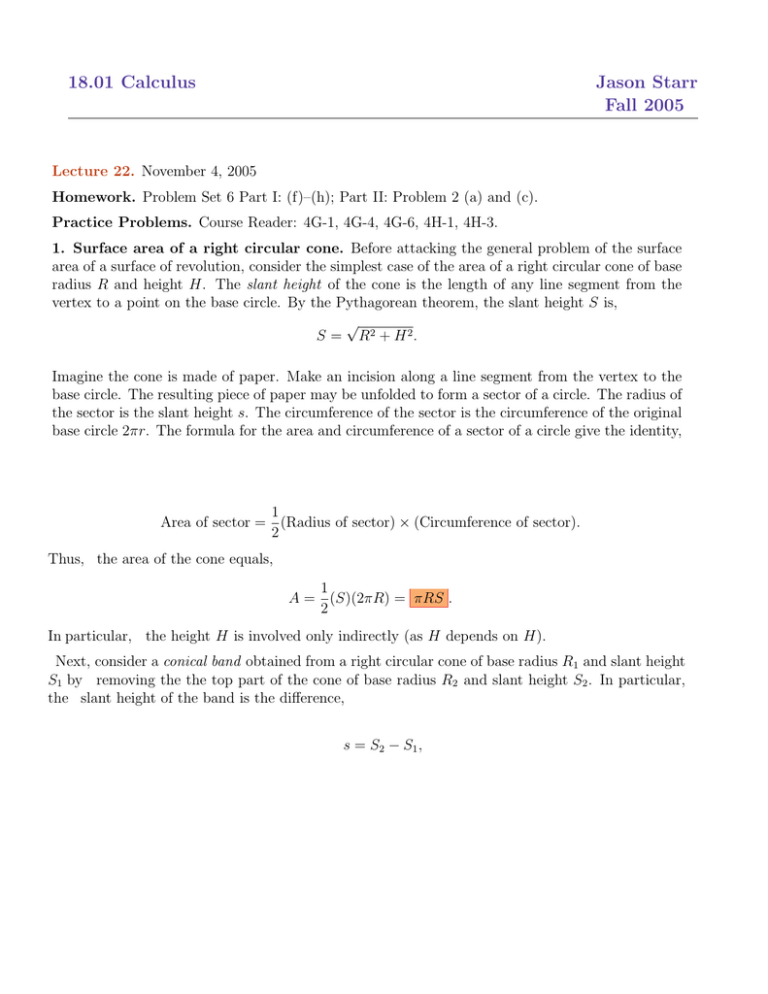
18.01 Calculus Jason Starr Fall 2005 Lecture 22. November 4, 2005 Homework. Problem Set 6 Part I: (f)–(h); Part II: Problem 2 (a) and (c). Practice Problems. Course Reader: 4G­1, 4G­4, 4G­6, 4H­1, 4H­3. 1. Surface area of a right circular cone. Before attacking the general problem of the surface area of a surface of revolution, consider the simplest case of the area of a right circular cone of base radius R and height H. The slant height of the cone is the length of any line segment from the vertex to a point on the base circle. By the Pythagorean theorem, the slant height S is, √ S = R2 + H 2 . Imagine the cone is made of paper. Make an incision along a line segment from the vertex to the base circle. The resulting piece of paper may be unfolded to form a sector of a circle. The radius of the sector is the slant height s. The circumference of the sector is the circumference of the original base circle 2πr. The formula for the area and circumference of a sector of a circle give the identity, 1 Area of sector = (Radius of sector) × (Circumference of sector). 2 Thus, the area of the cone equals, 1 A = (S)(2πR) = πRS . 2 In particular, the height H is involved only indirectly (as H depends on H). Next, consider a conical band obtained from a right circular cone of base radius R1 and slant height S1 by removing the the top part of the cone of base radius R2 and slant height S2 . In particular, the slant height of the band is the difference, s = S 2 − S1 , 18.01 Calculus Jason Starr Fall 2005 and the average radius of the band is the average of R1 and R2 , 1 r = (R1 + R2 ). 2 By similar triangles, S2 S1 = . R1 R2 Rearranging gives, R 2 S 1 = R 1 S2 . Using the formula above, the area of the large cone is, A1 = πR1 S1 , and the area of the small cone is, A2 = πR2 S2 . The area A of the band is the difference, A = A1 − A2 = π(R1 S1 − R2 S2 ). Since R2 S1 equals R1 S2 , the formula is unchanged by adding πR2 S1 and subtracting πR1 S2 to get, A = π(R1 S1 − R2 S2 ) + π(R2 S1 − R1 S2 ) = π((R1 + R2 )S1 − (R1 + R2 )S2 ). Simplifying and substituting R1 + R2 = 2r and S1 − S2 = 2 gives, A = 2πrs. 2. Surface area of a surface of revolution. Given a segment of a parametric curve, � x = x(t), a≤t≤b y = y(t) the surface of revolution is the surface obtained by revolving the segment through xyz­space about the y­axis. What is the area of this surface? The answer is called the surface area. The method for computing the surface area is so close to the method for computing the arc length of the curve, the details will be skipped. What is relevant is the differential element of surface area. Given a small interval from t to t + dt, approximate the segment of the parametric curve as a line segment. The surface obtained by revolving a line segment is precisely a band of a cone. The average radius of the cone r is x(t). The slant height of the cone is ds. Thus the area of the band is, �� � � �2 dx 2 dA = 2πrds = 2πx(t) + dy dt. dt dt 18.01 Calculus Jason Starr Fall 2005 Integrating gives the formula for the surface area of the surface of revolution, � �� � � �2 � t=b dx 2 A = dA = t=a 2πx(t) + dy dt. dt dt Examples. A. Consider the line segment connecting the point (0, H) to the point (R, 0). This has equation, H y = (R − x), 0 ≤ x ≤ R. R The slant height of the line segment is, √ S = R2 + H 2 , and the differential arc length of the line segment is, ds = S dx. R Thus the differential element of surface area is, S dA = 2πrds = 2πx dx. R Integrating gives, � x=R � A= dA = x=0 2πS 2πS xdx = R R � 2 �R x �� = πRS . 2 �0 This is the same formula obtained above by more elementary means. B. Consider the parametrized semicircle of radius R in the first and third quadrants, � π x = R cos(θ), −π ≤θ≤ . y = R sin(θ) 2 2 Revolving about the y­axis gives the sphere of radius R. Thus the surface area of the surface of revolution is the surface area of the sphere of radius R. As computed in the previous lecture, the differential element of arc length is, ds = Rdθ. Thus the differential element of surface area is, dA = 2πrds = 2πx(θ)(Rdθ) = 2π(R cos(θ))(Rdθ) = 2πR2 cos(θ)dθ. Integrating gives, � � A= θ=π/2 dA = θ=−π/2 π/2 2πR2 cos(θ)dθ = 2πR2 (sin(θ)|−π/2 . 18.01 Calculus Jason Starr Fall 2005 This evaluates to, A = 2πR2 (2) = 4πR2 . The fastest way to remember this is to observe the surface area A and the volume V of a sphere of radius R are related by, dV d A = 4πR2 = = (4πR3 /3). dr dr C. An astroid is a curve, x2/3 + y 2/3 = a2/3 . The part of the astroid in the first quadrant has parametric equation, � π x = a cos3 (t), 0≤t≤ . 3 y = a sin (t) 2 The derivatives are, dx dy = −3a cos2 (t) sin(t), = 3a sin2 (t) cos(t). dt dt Thus, � � 2 � �2 dx dy + = (−3a cos2 (t) sin(t))2 + (3a sin2 (t) cos(t))2 = 9a2 sin2 (t) cos2 (t)(cos2 (t) + sin2 (t)). dt dt The square root is, �� dx dt �2 � + dy dt �2 = � 9a2 sin2 (t) cos2 (t) = 3a sin(t) cos(t). So the differential element of arc length is, ds = 3a sin(t) cos(t)dt. Thus the differential element of surface area of the surface of revolution is, dA = 2πrds = 2πx(t)ds = 2π(a cos3 (t))(3a sin(t) cos(t))dt = 6πa2 cos4 (t) sin(t)dt. Integrating, the surface area is, � A= � t=π/2 dA = 6πa2 cos4 (t) sin(t)dt. t=0 Subsitute u = cos(t), du = − sin(t)dt, u(0) = 1, u(π/2) = 1 to get, � u=0 � u=1 2 4 2 A= 6πa u (−du) = 6πa u4 du. u=1 u=0 18.01 Calculus Jason Starr Fall 2005 Thus the surface area of the surface of revolution is, �1 � A = 6πa2 u5 /5� 0 = 6πa2 /5. 3. Polar coordinate curves. After the explicit, Cartesian form of a curve as a graph, y = f (x), the next most common representation is using polar coordinates. Given a function r = r(θ) and an interval a ≤ θ ≤ b, the associated polar coordinate curve is the parametric curve, � x = r(θ) cos(θ), a ≤ θ ≤ b. y = r(θ) sin(θ) For each point on the curve, the distance of the point from the origin is, � � √ +r, r ≥ 0, 2 2 2 Distance from origin = x + y = r = |r| = −r, r < 0 Also, assuming the point does not equal the origin, the angle of the ray from the origin to the point is, � θ, r > 0, −1 −1 Angle = tan (y/x) = tan (tan(θ)) = θ + π, r < 0 This is one of the most confusing aspects of polar curves. The symbols r(θ) and θ are engrained in mathematical thinking as the distance and angle of a point in polar coordinates. But for a polar coordinate curve these are simply parameters. They are very closely related to, but often different from, the actual distance and angle. This is easiest to think about by imagining the point swerving through the origin along the radius line to the opposite ray of the ray given by θ. In other words, the point “goes negative”. Given a polar curve, it is often possible to find an implicit Cartesian curve containg the polar curve. Examples. A. Let a be a positive constant and consider the polar curve, r(θ) = a. This gives, r2 = a2 ⇔ x2 + y 2 = a2 . Thus the polar curve is contained in the circle of radius a. B. Consider the polar curve, r(θ) = a . sin(θ) Multiplying both sides by sin(θ) gives, r sin(θ) = a ⇔ y = a. Thus the polar curve is contained in the horizontal line passing through (0, a). 18.01 Calculus Jason Starr Fall 2005 C. Consider the polar curve, r = 2a cos(θ), Multiplying both sides by r gives, r2 = 2ar cos(θ) ⇔ x2 + y 2 = 2ax. Simplifying this gives the equation, (x − a)2 + y 2 = a2 . This is the equation of the circle of radius a centered at (a, 0). 4. Sketching polar curves. Given a polar curve, how are we to sketch it? For definiteness, consider the polar curve, r(θ) = cos(2θ), −π/4 ≤ θ ≤ 7π/4. This curves is called the four­leaved rose. A similar curve occurs in Part II, Problem 2 of Problem Set 6. 1. Find the range of θ. In almost every case, this will be given. In this case, the range is given as −π/4 ≤ θ ≤ 7π/4. In some cases, the range must be determined. For instance, to sketch only the “leaf” of the rose containing (1, 0), first the endpoints of this leaf must be found. 2. Determine when r is positive, zero or negative. This is easiest to keep track of with a table. θ −π/4 −π/4 < θ < π/4 π/4 π/4 < θ < 3π/4 3π/4 3π/4 < θ < 5π/4 5π/4 5π/4 < θ < 7π/4 r r r r r 0 >0 0 <0 0 >0 0 <0 The curve crosses the origin when θ = −π/4, π/4, 3π/4, and 5π/4. The curve “goes negative” when π/4 < θ < 3π/4 and when 5π/4 < θ < 7π/4. 3. Find the extremal values of |r|. A local maximum of |r| is either a point where r is positive and a local maximum or a point where r is negative and a local minimum. Similarly for local minima of |r|. Typically, local maxima of |r| occur either at endpoints of the interval or points where r� (θ) is zero (occasionally at discontinuity points, or nondifferentiable points). Local minima occur at such points, but also occur everytime the curve crosses the origin (so that |r| equals 0). 18.01 Calculus Jason Starr Fall 2005 In our example, the local minima are all points where r = 0, enumerated above. The derivative of r is, r� (θ) = −2 sin(2θ). The critical points are θ = 0, π/2, π and 3π/2. For θ = 0 and θ = π, r is positive and maximum. For θ = π/2 and θ = 3π/3, r is negative and minimum. Thus each critical point is a local maximum of |r|. The value of |r| at each critical point is 1. 4. Find the asymptotes. This is a bit difficult with a polar curve. What is easier is to find a line parallel to an asymptote. Whenever, lim r(θ) = +∞, θ→a (or the same with a right­hand limit or left­hand limit), there is an asymptote parallel to the ray θ = a. Whenever, lim r(θ) = −∞, θ→a there is an asymptote parallel to the ray θ = a + π. In our example, r(θ) never limits to ±∞. Thus there are no asymptotes. But in Example B., r = a/ sin(θ), r tends to +∞ as θ tends to 0 from above and as θ tends to π from below. Thus there is an asymptote parallel to the x­axis. Since the explicit equation is y = a, which is a line parallel to the x­axis, this is correct. 5. Find the tangent direction at important points. This will be discussed further next time. The most important tangent directions are when the curve crosses the origin, and critical points of r. If r(θ) = 0 and r� (θ) �= 0, the tangent line of the curve has angle θ. If r� (θ) = 0 and r(θ) �= 0, the tangent line has angle θ ± π/2, i.e., the tangent line is orthogonal to the radius through the point. Both of these are consequences of a more general formula. The angle ψ between the tangent line and the radius satisfies, r(θ) tan(ψ) = � . r (θ) In the example, r� is nonzero whenever r is zero. Thus the tangent direction of the curve as it crosses the origin is just the direction of the limiting radius. This is now ample information to sketch the four­leaved rose. Up to a rotation of π/4, the sketch is the same as in Figure 16.11 on p. 566 of the textbook (the sketch was also given in lecture).
